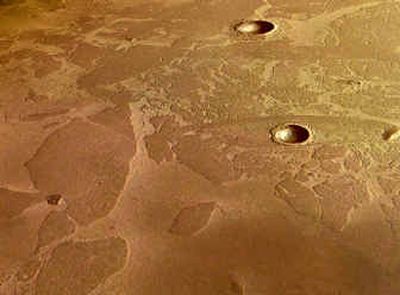Scientists call for new Mars mission

NOORDWIJK, Netherlands – Scientists said Friday they have discovered possible evidence of frozen seas and volcanic activity on Mars and called for a follow-up mission to find out if there is life on the red planet.
The recommendations came at the end of a weeklong meeting in the Netherlands held to analyze results from the European Space Agency’s Mars probe.
A straw poll conducted among 250 participants of the conference showed that 75 percent believe that life in the form of bacteria once existed on Mars. Twenty-five percent thought there might still be life on the planet.
Scientists have long theorized there was once water on Mars, the planet most like Earth in our solar system, and data from NASA’s Mars Rovers has recently appeared to confirm it. But most believed the water had evaporated away early in the planet’s history, leaving it cold and dry.
Now it appears Mars’s core may interact with the surface, meaning there is both warmth and moisture in the planet’s recent past.
“This mysterious lady is slowly revealing her secrets,” NASA scientist Everett Gibson said. “From what we’ve seen, Mars meets all the requirements that are needed for life to exist.”
The conference revealed the likely existence of a frozen sea near its equator, as well as signs of lava flows 20 million years ago.
“You can see baby (volcanic) cones. I think they’re still growing,” said Professor Gerhard Neukum, who led the analysis of the high-resolution photographs taken by the Mars Express probe orbiting the planet for the past year.
“I cannot prove it, but the evidence is very suggestive,” he said.
News of the discovery of the frozen sea – which is the size of Earth’s North Sea and appears similar to ice packs on Antarctica in photos – made international science headlines on Tuesday.
Gibson, an American invited to join in the analysis of the ESA project, said “our perception has changed” because of the week’s findings.
“The closest thing I can compare it to was when we had samples back from the moon,” Gibson said. “This week we had good data back from Mars.”
ESA’s science director David Southwood said the quality of the results from the ESA project and the NASA rovers showed it was time for governments to sponsor a new mission to reach the planet’s surface and perhaps bring samples back to Earth.
“You don’t go back to Mars on the cheap,” he said, calling for funding. “No money, no mission.”
The ESA probe, which cost $264 million, featured seven different projects, including a chemical analysis of Mars’ atmosphere measuring the amount of carbon dioxide, methane and other gases.
Further testing showed the existence of clay and gypsum deposits formed by water in the soil and indicated that up to 100 tons per day of matter is being blown off the planet into space by the solar wind.
A French group found that Mars’s ozone layer is thinnest where water vapor is thickest, a finding with possible implications for Earth, where water vapor in the upper atmosphere is believed to be rising.